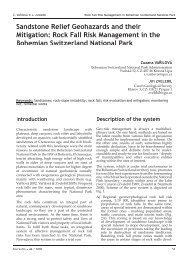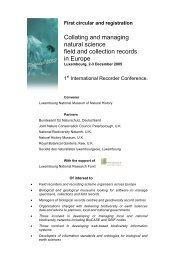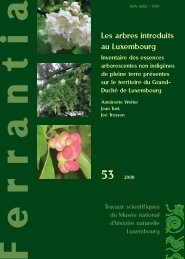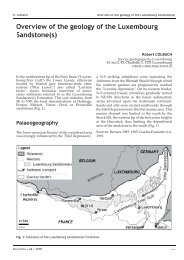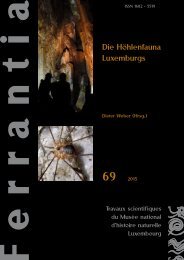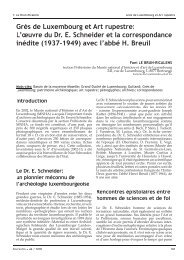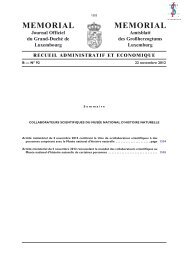Preface of the Editors - Musée national d'histoire naturelle
Preface of the Editors - Musée national d'histoire naturelle
Preface of the Editors - Musée national d'histoire naturelle
You also want an ePaper? Increase the reach of your titles
YUMPU automatically turns print PDFs into web optimized ePapers that Google loves.
C. Ries & Y. Krippel <strong>Preface</strong> <strong>of</strong> <strong>the</strong> <strong>Editors</strong><strong>Preface</strong> <strong>of</strong> <strong>the</strong> <strong>Editors</strong>Christian RIESDepartment <strong>of</strong> Ecology, National Museum <strong>of</strong> Natural History25, rue Münster, L-2160 Luxembourgcries@mnhn.luYves KRIPPELResearch associate <strong>of</strong> <strong>the</strong> Luxembourg National Museum <strong>of</strong> Natural History18A, rue de Rollingen, L-7475 Schoosyves.krippel@mnhn.luIntroductionYou hold in hands <strong>the</strong> proceedings <strong>of</strong> <strong>the</strong> secondinter<strong>national</strong> conference on sandstone landscapesthat took place in Vianden (Luxembourg) fromMay 25 to May 28 2005. The conference entitled“Sandstone landscapes in Europe - Past, present andfuture” brought toge<strong>the</strong>r a range <strong>of</strong> scientists,experts, teachers and students from all overEurope.This inter<strong>national</strong> sandstone symposium followed<strong>the</strong> initial conference “Sandstone Landscapes:Diversity, Ecology and Conservation” that took placein Doubice in Saxonian-Bohemian Switzerland,Czech Republic in September 2002 (Härtel et al.2002).The proposal for <strong>the</strong> follow-up symposium was broughtto Luxembourg by a Luxembourg participant whoaended <strong>the</strong> Czech symposium.The “Groupe d’études ayant pour objet la conservationdu patrimoine naturel de la Petite-Suisse luxembourgeoise”,an advisory group created by <strong>the</strong> LuxembourgGovernment to promote <strong>the</strong> conservation<strong>of</strong> remarkable natural sites in <strong>the</strong> Luxembourgsandstone area, <strong>the</strong> Müllerthal, also known as<strong>the</strong> “Petite-Suisse luxembourgeoise”, supported<strong>the</strong> initiative to organize <strong>the</strong> next sandstonesymposium in Luxembourg.So <strong>the</strong> idea made its way, a partnership was set upand <strong>the</strong> symposium was scheduled for May 2005.OrganizationOrganizations and persons are listed in alphabeticalorder.Main organizers• Administration des eaux et forêts (Water andforestry administration)• Musée <strong>national</strong> d’histoire <strong>naturelle</strong> (NationalMuseum <strong>of</strong> Natural History)• Musée <strong>national</strong> d’histoire et d’art (NationalMuseum <strong>of</strong> History and Art)• Société des naturalistes luxembourgeois(Luxembourg Naturalist Society)Partner organizations• Amis de la géologie, de la minéralogie et dela paléontologie du Luxembourg (Friends <strong>of</strong>geology, mineralogy and palaeontology inLuxembourg)• Association des géologues luxembourgeois(Luxembourg geologists association)• Fondation Hëllef fir d’Natur (Help for naturefoundation)• LAG LEADER+ Mullerthal (Local action groupLeader +)• NATURA - Ligue luxembourgeoise pour laprotection de la nature et de l'environnement(Luxembourg league for <strong>the</strong> environment andnature conservation)• Naturerkundungsstation(Nature visitor center)Teufelsschlucht• Oeko-Zenter Lëtzebuerg (Environmental andnature conservation foundation)• Service géologique du Luxembourg (Geologicalsurvey <strong>of</strong> Luxembourg)• Société préhistorique luxembourgeoise(Luxembourg prehistorical society)Conference coordination and secretariate• Christian Ries, curator at <strong>the</strong> National Museum<strong>of</strong> Natural History, president <strong>of</strong> <strong>the</strong> LuxembourgNaturalist SocietyFerrantia • 44 / 2005 7
C. Ries & Y. Krippel <strong>Preface</strong> <strong>of</strong> <strong>the</strong> <strong>Editors</strong>Conference scientific commiee• Guy Colling, researcher at <strong>the</strong> NationalMuseum <strong>of</strong> Natural History• Alain Faber, curator at <strong>the</strong> National Museum <strong>of</strong>Natural History• Yves Krippel, research associate <strong>of</strong> <strong>the</strong> NationalMuseum <strong>of</strong> Natural History• Christian Ries, curator at <strong>the</strong> National Museum<strong>of</strong> Natural History, president <strong>of</strong> <strong>the</strong> LuxembourgNaturalist Society• Jean-Marie Sinner, head <strong>of</strong> Diekirch forestrydistrict, Water and Forests Administration• Fernand Spier, president <strong>of</strong> <strong>the</strong> LuxembourgPrehistory Society• Norbert Stomp, honorary director <strong>of</strong> <strong>the</strong>National Museum <strong>of</strong> Natural History• François Valoeau, researcher at <strong>the</strong> NationalMuseum <strong>of</strong> History and Art• Jean Werner, president <strong>of</strong> <strong>the</strong> Study groupfor <strong>the</strong> preservation <strong>of</strong> <strong>the</strong> natural heritage <strong>of</strong>Luxembourg Lile SwitzerlandConference organizing commiee• Georges Bechet, director <strong>of</strong> <strong>the</strong> NationalMuseum <strong>of</strong> Natural History• Marie-Paule Kremer, Ministry <strong>of</strong> Environment• Frantz-Charles Muller, president <strong>of</strong> Foundation'Hëllef fir d’Natur' and NATURA• Christian Ries, curator at <strong>the</strong> National Museum<strong>of</strong> Natural History, president <strong>of</strong> <strong>the</strong> LuxembourgNaturalist Society• Jean-Marie Sinner, head <strong>of</strong> Diekirch forestrydistrict, Water and Forests Administration• François Valoeau, researcher at <strong>the</strong> NationalMuseum <strong>of</strong> History and ArtBackground and aims<strong>of</strong> <strong>the</strong> conferenceSandstone regions are scaered all over Europe.Even if different in age and composition, <strong>the</strong>yall show a great number <strong>of</strong> similitudes. Distinctgeomorphologic features oen create stronggradients in mesoclimatic conditions and generatehigh levels <strong>of</strong> natural disturbance and resultingpatch dynamics. In sandstone regions <strong>the</strong>sedynamic geomorphologic processes occur at ratesunseen in <strong>the</strong> surroundings. The special climaticor microclimatic conditions in sandstone regionsinduce a mosaic <strong>of</strong> biotopes hosting specific floraand fauna. The occurring species are oen <strong>of</strong> relictnature and a testimony <strong>of</strong> climatic conditions andvegetation in place earlier in this interglacial.Sandstone areas are not only a phenomenon <strong>of</strong>geological and biological interest. They are wellknown for <strong>the</strong>ir prehistoric past, and rock sheltersprovided excellent opportunities for humanselements. Later, <strong>the</strong> outstanding landscapes <strong>of</strong>sandstone regions have aracted human aention,particularly since <strong>the</strong> Romantic period. It was<strong>the</strong> beginning <strong>of</strong> tourism, a phenomenon thatnowadays oen causes irreversible problems in<strong>the</strong>se fragile environments.In order to preserve <strong>the</strong> invaluable landscapes andecosystems, associated to sandstone landscapes,<strong>the</strong>re is a strong need for research, nature andlandscape conservation with concrete managementplans, environmental friendly tourism, etc.The first sandstone conference in Doubice, CzechRepublic, revealed that <strong>the</strong> uniqueness <strong>of</strong> geomorphologicand ecological processes in sandstoneregions calls for a much more intimate linkbetween geomorphology, climatology, landscapehistory and biology/ecology, etc. and initiated<strong>the</strong> so-called 'sandstone community', a database<strong>of</strong> people interested in research and conservation<strong>of</strong> sandstone landscapes. More information canbe found on <strong>the</strong> 'Sandstone Landscapes' websitewww.sandstones.org, providing informationabout <strong>the</strong> research and events on sandstonelandscapes, especially in Europe (Härtel 2005).This second inter<strong>national</strong> conference on sandstonetried to carry on <strong>the</strong> effort devoted to bridgingall <strong>the</strong> concerned disciplines. The organizersintended that this conference would - amongsto<strong>the</strong>rs - identify which general research topicscan use sandstone regions as particularly suitablemodel systems; permit <strong>the</strong> comparison <strong>of</strong> differentsandstone regions in Europe and point out similarities;establish new contacts and fur<strong>the</strong>r collaborationamong people interested in sandstoneregions; address conservation issues specific forsandstone regions (tourism, rock climbing, restorationmanagement); etc.Scientific programmeThe scientific programme consisted <strong>of</strong> plenarylectures, poster sessions, discussions and excursions.Four major topics were covered by 26 oralcommunications and 16 posters:1. Evolution <strong>of</strong> sandstone landscapes:geology and geomorphologySandstone is a quite common rock type, whichcharacterizes different regions and yet each8Ferrantia • 44 / 2005
C. Ries & Y. Krippel <strong>Preface</strong> <strong>of</strong> <strong>the</strong> <strong>Editors</strong>sandstone formation differs somehow from <strong>the</strong>o<strong>the</strong>r by its mineralogical composition or by itsorigin. Today <strong>the</strong> geological evolution <strong>of</strong> <strong>the</strong>seareas shows a landscape revealing many erosionfeatures, joint paerns and rockslides fromrecent time, as well as a lot <strong>of</strong> elements from <strong>the</strong>geological past. The erosion oen formed ei<strong>the</strong>rnarrow valleys into a sandstone plateau, or slopes<strong>of</strong> a cuesta, or bues as residual hills or outliers,etc.2. Archaeology <strong>of</strong> sandstone landscapes:from Prehistory to <strong>the</strong> Middle AgesThere is no doubt about <strong>the</strong> importance <strong>of</strong>sandstone landscapes from Prehistory to <strong>the</strong>Middle Ages. Archaeology contributes to <strong>the</strong>knowledge <strong>of</strong> <strong>the</strong> old populations within <strong>the</strong>limits given by <strong>the</strong> subject. Following topics are<strong>of</strong> special interest: <strong>the</strong> habitat and its additionalactivities, as well as architecture; burials, anthropologyand taphonomy in sandy context; petroglyphsand rupestral art.3. Flora, fauna and microclimate <strong>of</strong>sandstone ecosystemsSandstone formations with <strong>the</strong>ir typical erosionfeatures are known for special microclimaticconditions. Great variations in both humidity andtemperature - including temperature inversion -are responsible for a huge diversity <strong>of</strong> plants andanimals. The proliferation <strong>of</strong> Atlantic and sub-Atlantic species is remarkable; <strong>the</strong> presence <strong>of</strong>mountain and sub-mountain species is significant.Besides higher plants, <strong>the</strong> diversity <strong>of</strong> pteridophytesand <strong>the</strong> richness <strong>of</strong> nonvascular cryptogamslike bryophytes and lichens <strong>of</strong> sandstone regionsis in general outstanding. On <strong>the</strong> o<strong>the</strong>r hand, <strong>the</strong>sandstone outcrops, as well as extended woodsand moist valleys <strong>of</strong>fer habitats for a rich wildlife.4. Human impact on sandstonelandscapes: threats and protectionSandstone landscapes oen became <strong>the</strong> victims<strong>of</strong> <strong>the</strong>ir own success. Exploited and inhabitedby man since prehistory, visited and solicited bymodern man, seeking relaxation and ventures in<strong>the</strong>se spectacular landscapes, <strong>the</strong> extreme fragilesandstone habitats are more and more threatened.In order to preserve <strong>the</strong> natural and culturalheritage <strong>of</strong> sandstone landscapes, concretemeasures must be initiated and a tourism in accordancewith <strong>the</strong> environment promoted.Course <strong>of</strong> <strong>the</strong> Symposium88 participants aended <strong>the</strong> conference, includingspeakers and translation staff (cf. list <strong>of</strong> participants).Pre-conference excursionThe pre-conference excursion on WednesdayMay 25 took <strong>the</strong> participants by bus to <strong>the</strong> heart<strong>of</strong> <strong>the</strong> “Petite Suisse” area. The participants weresplit into two groups according to <strong>the</strong> conferencelanguages English and French.On <strong>the</strong> programme: sandstone formations, forestsand valleys around Berdorf and Beaufort (Fig. 1).The prehistoric sites <strong>of</strong> 'Kalekapp', petroglyphsand vandalism, rock formations and erosion,different forest associations, flora (including filmyferns), fauna, rock climbing and related problems,tourism as well as nature conservation, were onlysome <strong>of</strong> <strong>the</strong> topics.The field trip was ra<strong>the</strong>r demanding, but <strong>the</strong>barbecue during lunch break in <strong>the</strong> stunningscenery <strong>of</strong> Beaufort castle helped to forget achinglegs and sunburn.The guides were: Guy Colling, Alain Faber, AnneHauzeur, Yves Krippel, Jean-Marie Sinner andFrançois Valoeau.The conferenceThe plenary sessions lasted <strong>the</strong> next two days, fromThursday May 26 to Friday May 27. The venuewas <strong>the</strong> 'Centre culturel Larei', a former tannerycomplex transformed by <strong>the</strong> city <strong>of</strong> Vianden into acultural centre. An abstract book was provided by<strong>the</strong> organizers (Ries 2005).Instead <strong>of</strong> grouping <strong>the</strong> communications by major<strong>the</strong>mes into distinct Symposia, <strong>the</strong> organizingcommiee was so audacious to mix up <strong>the</strong>contributions independently <strong>of</strong> <strong>the</strong>ir topic (cf.Fig. 1: Pre-conference excursion in <strong>the</strong> Müllerthal area,May 25 2005. Photo: Milkuláš Radek.Ferrantia • 44 / 2005 9
C. Ries & Y. Krippel <strong>Preface</strong> <strong>of</strong> <strong>the</strong> <strong>Editors</strong>programme). Under <strong>the</strong> boom line, as everybodyagreed, this atypical method was <strong>of</strong> great success.It is quite unusual that <strong>the</strong> last speaker <strong>of</strong> <strong>the</strong> daycan find himself in front <strong>of</strong> a full auditory, mostpeople having aended all day long. Of coursethis fact is also due to <strong>the</strong> excellent quality <strong>of</strong> <strong>the</strong>contributions and to <strong>the</strong> fact that <strong>the</strong> programmewas reliable, all speakers perfectly respecting <strong>the</strong>irallocated time.We are especially thankful to Handrij Härtel andJan Čeřovský who draw general conclusions at<strong>the</strong> conference closure and called for joining <strong>the</strong>sandstone community and for meeting again at <strong>the</strong>next conference which will be held in Poland in acouple <strong>of</strong> years. Jan Čeřovský draw <strong>the</strong> aentionto <strong>the</strong> range <strong>of</strong> activities and working groups<strong>of</strong> <strong>the</strong> IUCN and proposed that <strong>the</strong> sandstonecommunity should create an IUCN-workinggroup covering <strong>the</strong> issues <strong>of</strong> sandstone areas.On Friday May 27, aer <strong>the</strong> second morningsession, <strong>the</strong> organizers were happy to present<strong>the</strong> book about <strong>the</strong> Petite-Suisse area and to <strong>of</strong>fera copy to each participant (Fig. 2). The bookcomprises 251 pages and covers all <strong>the</strong> topics <strong>of</strong><strong>the</strong> conference (Krippel 2005).Aer <strong>the</strong> conference closure, <strong>the</strong> tourist train'Benni' took <strong>the</strong> participants to a guided visit <strong>of</strong> <strong>the</strong>hydro electrical power plant SEO near Stolzembourg.The conference dinner took place <strong>the</strong> sameevening in <strong>the</strong> Hotel Victor Hugo in Vianden.Post-conference excursionThe post-conference excursion took <strong>the</strong> participantsby bus to <strong>the</strong> German part <strong>of</strong> <strong>the</strong> Luxembourgsandstone area near Ernzen and Ferschweiler.Again <strong>the</strong> participants were split into twogroups according to <strong>the</strong> conference languagesEnglish and French.Fig. 2: Presentation <strong>of</strong> <strong>the</strong> book about <strong>the</strong> Petite-Suissearea in front <strong>of</strong> <strong>the</strong> conference venue Larei, May 272005. Photo: Milkuláš Radek.Fig. 3: Post-conference excursion, Luxembourg-city,view on <strong>the</strong> Alzette valley and <strong>the</strong> Grund district, May28 2005. Photo: Jiří Adamovič.Aer a glance at <strong>the</strong> visitor centre 'NaturerkundungszentrumTeufelsschlucht', a trail took <strong>the</strong>participants through sandstone formations anddeciduous woods to <strong>the</strong> valley <strong>of</strong> <strong>the</strong> Prüm and<strong>the</strong> 'Irreler Wasserfälle', small waterfalls caused byenormous rock boulders.The aernoon was spent in Luxembourg-citycovering geological, historical and botanical topics(Fig. 3). The excursion ended with a visit <strong>of</strong> twomajor museums, <strong>the</strong> National Museum <strong>of</strong> NaturalHistory and <strong>the</strong> National Museum <strong>of</strong> History andArt.The guides were: Georges Bechet, Alain Faber,Anne Hauzeur, François Valoeau and HolgerWeber.ConclusionOn behalf <strong>of</strong> <strong>the</strong> organizers we thank all <strong>the</strong>participants having aended <strong>the</strong> conference andespecially those who have contributed to <strong>the</strong>programme excellence with a high diversity andquality <strong>of</strong> oral communications and poster presentations.The magnificent wea<strong>the</strong>r conditions, <strong>the</strong> gorgeousconference venue and last but not least <strong>the</strong> sociabilityand sincerity <strong>of</strong> <strong>the</strong> participants made thissymposium a remarkable event that will not beforgoen soon.The conference showed clearly <strong>the</strong> similitude <strong>of</strong><strong>the</strong> different sandstone landscapes scaered allover Europe and <strong>the</strong> similarities <strong>of</strong> <strong>the</strong> problematic<strong>of</strong> conservation <strong>of</strong> natural and cultural heritagesin <strong>the</strong> different regions. By ga<strong>the</strong>ring participants<strong>of</strong> o<strong>the</strong>r countries, <strong>the</strong> Sandstone Community wasenlarged and <strong>the</strong>re was a clear consensus to joinefforts in <strong>the</strong> future.10Ferrantia • 44 / 2005
C. Ries & Y. Krippel <strong>Preface</strong> <strong>of</strong> <strong>the</strong> <strong>Editors</strong>We hope <strong>the</strong>se proceedings will contribute tospread knowledge about one <strong>of</strong> <strong>the</strong> most sensiblelandscape types in Europe and will increasenetworking amongst <strong>the</strong> scientific communityworking in and on sandstone areas.AcknowledgementsWe are grateful to a range <strong>of</strong> persons and institutionswhich have helped in many ways and thuscontributed to <strong>the</strong> success <strong>of</strong> <strong>the</strong> conference. Thesepersons and institutions are listed by type andin alphabetical order. We express <strong>the</strong>se thankson behalf <strong>of</strong> <strong>the</strong> main organizers, <strong>the</strong> partnerorganizations and <strong>the</strong> scientific and organizingcommiees.Excursion guides• Georges Bechet (National Museum <strong>of</strong> NaturalHistory, Luxembourg)• Guy Colling (National Museum <strong>of</strong> NaturalHistory, Luxembourg)• Alain Faber (National Museum <strong>of</strong> NaturalHistory, Luxembourg)• Anne Hauzeur (research associate, NationalMuseum <strong>of</strong> History and Art, Luxembourg)• Yves Krippel (research associate, NationalMuseum <strong>of</strong> Natural History, Luxembourg)• Jean-Marie Sinner (Forestry administration,Diekirch)• François Valoeau (National Museum <strong>of</strong>History and Art, Luxembourg)• Holger Weber (NaturerkundungszentrumTeufelsschlucht, Germany)Staff• Bastin Jonny (Municipality <strong>of</strong> Vianden,conference venue Larei)• Pascal Dellea (driver)• Nadine De SousaDiekirch)(student, Hotel school• Véronique Maurer (student, Hotel schoolDiekirch)• Tom Müller (Forestry administration, Beaufort)and his team (barbecue in Beaufort Castle)Graphical work• Anita Faber (National Museum <strong>of</strong> NaturalHistory, Luxembourg)• Thierry Helminger (National Museum <strong>of</strong>Natural History, Luxembourg)Sponsors• Fonds <strong>national</strong> de la recherche, Luxembourg(National Research Fund)• Luxembourg Presidency <strong>of</strong> <strong>the</strong> Council <strong>of</strong> <strong>the</strong>European Union• Ministry <strong>of</strong> Culture, Higher Education andResearch, Luxembourg• Ministry <strong>of</strong> Environment, Luxembourg• Ministry <strong>of</strong> Foreign Affairs, Luxembourg• Μrs. Anne-Marie Linkels (Castle <strong>of</strong> Beaufort)• Municipality <strong>of</strong> Beaufort• Municipality <strong>of</strong> Vianden• SEO, Société électrique de l’Our, Vianden• Tourist <strong>of</strong>fice <strong>of</strong> ViandenCompanies• Accents sprl, Brussels (Simultaneous translation)• Alltec solution providers, Luxembourg(Materials)• Autolux sàrl, Luxembourg (Car rental)• Dorel Doreanu, Senningen (Music)• Economat Stronska Fons, Vianden (Catering)• E.G.E. Stienon sprl, Brussels (Sound and simultaneoustranslation technique)• Hammes sàrl, Vianden (Tourist train Benni)• Hotel Victor Hugo, Vianden (Catering)• Hotel Petry, Vianden (Catering)• Maison Bernard Bergh, Vianden (Materials)• Shop Vinandy, Vianden (Fuel)• Voyages Demy Schandeler, Keispelt (Bus transportation)ReferencesHärtel H. 2005. - Sandstone Landscapes. Website<strong>of</strong> <strong>the</strong> Sandstone Community. Url: hp://www.sandstones.org/s_conf.htm [15.11.2005].Härtel H., Herben T. & Cílek V. 2002. - SandstoneLandscapes: Diversity, Ecology and Conservation.Conference homepage. Url: hp://www.sandstones.org/ibot_sandstone/index.htm [15.11.2005].Krippel Y. [ed.] 2005. - Die Kleine LuxemburgerSchweiz - Geheimnisvolle Felsenlandscha imWandel der Zeit. Luxembourg. 251p. ISBN 2-919877-09-7.Ries C. 2005. - Sandstone landcapes in Europe- Past, present and future. 2 nd Inter<strong>national</strong>Conference on sandstone landcapes. Conferenceabstracts - Préactes de la conférence.Url: hp://www.symposium.lu/symposium/sandstone/preactes.pdf [15.11.2005]Ferrantia • 44 / 2005 11
Conference posterPoster de la conférence2 nd inter<strong>national</strong> conference on sandstone landscapesSandstone landscapes in Europe - Past, present and future2 ème conférence inter<strong>national</strong>e sur les paysages de grèsPaysages de grès en Europe - Passé, présent et futur25.-28. 05. 2005 Vianden (Luxembourg)w w w . s y m p o s i u m . l u / s a n d s t o n ePoster layout: Thierry Helminger (MNHNL). Logo design: Anita Faber (MNHNL)12Ferrantia • 44 / 2005



